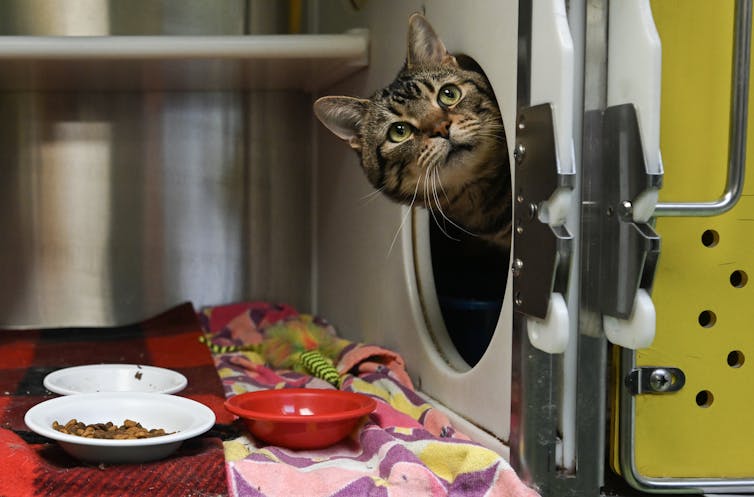The benefits of pet companionship have been widely researched and celebrated.
Pets can improve our mood and immune system. They can also encourage staying active and fit, offer emotional comfort and companionship, and foster social connections. Pets can even increase life expectancy.
Unfortunately, pet companionship is not always easily accessible to everyone. Several groups face hurdles when it comes to sharing time or living with a pet. Some of the hurdles that people can face when accessing pets include the lack of pet-friendly housing and financial resources to afford pet food and veterinary care.
There can also be more concrete barriers to pet companionship, such as no-pet clauses in rental agreements or no-pet policies in retirement homes.
As we strive for social equality, it is essential to address hurdles that prevent some people from experiencing the known benefits of spending time or living with a pet.
THE CANADIAN PRESS/Sean Kilpatrick
Challenges and misconceptions
Several factors can make pet companionship less accessible. Some of these factors include lack of appropriate housing and lack of financial resources for pet food and pet-related veterinary services. A Canadian survey found that new immigrants and young people aged 18 to 34 years are the groups most affected by these factors and, often, elderly people experience housing-related and financial challenges.
For pet guardians, the inability to pay for grooming services, food or health-care services can create feelings of distress and, for their pets, this can lead to a reduced quality of life. In this case, we see that the well-being of both pet guardians and their beloved pets can be compromised.
Moreover, some studies link higher income to an increased likelihood of living with companion animals. When it comes to economic factors, it is concerning that some believe certain groups of people should not be pet guardians. The Michelson Found Animals Foundation highlights several misconceptions about living with companion animals, which are often associated with financial hardships.

THE CANADIAN PRESS/Graham Hughes
For example, some people believe that people who live in apartments, rather than homes with backyards and green space, should only have small dogs as pets. However, this belief ignores a dog’s energy level as some small dogs are highly energetic while some big dogs are less energetic. This belief also does not consider the guardian’s ability to provide mental and physical stimulation for their dog.
Still other people believe that if someone cannot afford the costs associated with caring for a pet, they should not have a one. This belief only reinforces social inequalities and reflects a deeper form of discrimination.
Financial problems and housing restrictions may force people to give up their pets, and this is an emotionally difficult decision. Research by Christine Yvette Tardif-Williams, one of the authors of this story, with childhood and youth researcher Rebecca Raby and graduate students at Brock University shows how homeless children often navigate feelings of emotional intimacy towards their pets alongside feelings of loss and grief. In this research, homeless children shared stories about missing or losing companion animals either through separation or death.
Research also shows that most people experiencing homelessness are responsible pet guardians, and that their pets are often very healthy and that they too benefit from human companionship — it’s a mutually beneficial, two-way emotional connection.
A more equitable future in pet companionship
Pet companionship and systemic inequalities are interconnected. For instance, many socioeconomically disadvantaged and marginalized families and communities — including, but not limited to, racialized, Indigenous, homeless, immigrant and refugee families and their children — face barriers to pet companionship.
We need targeted strategies and policies to reduce the barriers faced by these families and communities. It is important to create more opportunities for people and pets to live together. This can help us to address social inequality in pet companionship among diverse groups.
Some studies highlight the need for increasing access to free or low-cost veterinary care. Making shelters and housing more pet-friendly is also essential. Promoting campaigns to reduce misconceptions about pet companionship among diverse groups of people is another key strategy.

THE CANADIAN PRESS/Graham Hughes
One example of a program that helps make pet companionship more accessible is Community Veterinary Outreach (CVO).This is a registered charity located across different provinces in Canada. They provide health care for people and preventive care for pets. They also run education programs covering topics such as animal behaviour, nutrition, and dental care. Together, these services help to support vulnerable populations living with pets.
Another example is the PetCard program, a Canadian financing program that offers flexible options for people to split the payment of veterinary-related services.
Read more:
How ‘One Health’ clinics support unhoused people and their pets
However, we need more consistent collaborative work that begins by raising awareness about the importance of pet companionship for diverse groups of people. Expanding this discussion can help us design fairer policies about pet companionship, foster social justice and bring communities together.
Overlooking the relevance of this discussion can reinforce discriminatory views around pet companionship.
Supporting pet companionship
It is problematic when access to pet companionship is restricted due to a family’s economic status or housing opportunities, since it means they’re less likely to experience the well-being benefits of pet companionship. In this way, pet-related benefits are limited to a select and privileged group.
We can help people and animals build meaningful bonds by promoting equitable access to companionship. The needs of pets must also be prioritized in any effort to increase access to pet companionship. This means making sure pets’ physical and emotional needs are met and that they also benefit from the human-pet bond. Pets’ well-being and rights should always come first when making pet companionship more accessible.
To create a fair approach to supporting pet companionship among diverse populations, we need to balance human and pet needs and ensure the well-being of both humans and their pets.

The post “Promoting social inclusion through pet companionship” by Renata Roma, Postdoctoral Fellow, Center of Behavioural Sciences and Justice Studies/Pawsitive Connections Lab, University of Saskatchewan was published on 05/26/2025 by theconversation.com




































Leave a Reply